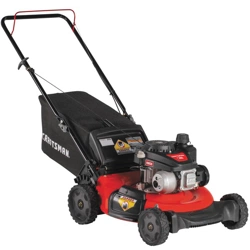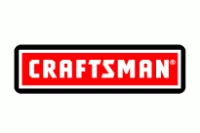Documents: Go to download!
User Manual
- Owner's manual - (English)
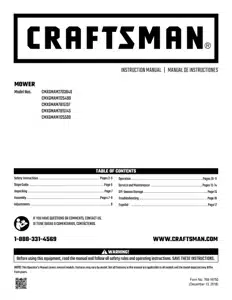
- ASSEMBLY
- ADJUSTMENTS
- OPERATION
- SERVICE AND MAINTENANCE
- OFF-SEASON STORAGE
- TROUBLESHOOTING
- SAFETY INSTRUCTIONS
Table of contents
INSTRUCTION MANUAL
ASSEMBLY
IMPORTANT: This unit is shipped without gasoline or oil in the engine. Be certain to service engine with gasoline and oil as instructed in the Operation section of the Engine Operator’s Manual before starting or running your machine.
NOTE: Reference to right and left hand side of the lawn mower is observed from the operating position.
Unpacking
Opening Carton
- Cut each corner of the carton vertically from top to bottom.
- Remove all loose parts.
- Remove loose packing material.
Removing Unit From Carton
- Lift unit from the rear to detach it from underlying carton material and roll unit out of carton.
- Check carton thoroughly for any other loose parts.
Loose Parts In Carton
- Grass Catcher
- Side Discharge Cover
- Engine Oil
Assembly
Attaching The Handle
1. Remove any packing material which may be between upper and lower handles.
a.Remove wing nuts and carriage bolts handle as shown in Figure 1. Do not loosen or remove adjacent hex head screws.
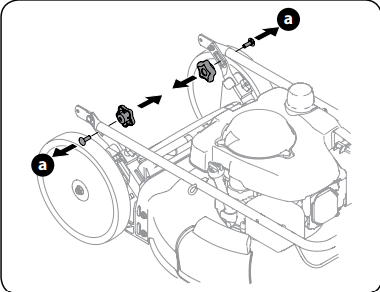
Figure 1
b. While stabilizing mower so it doesn’t move, pivot upper handle up as shown in Figure 2. Do not crimp cable while lifting the handle up.
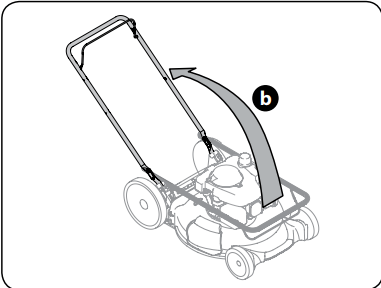
Figure 2
2. Remove T-bolts from the handle brackets as shown in Figure 3.
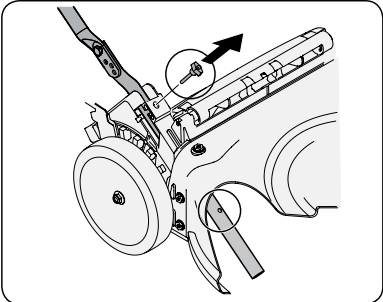
Figure 3
3. Follow the steps below to complete handle assembly:
a. Pull upward on the handle until holes in lower handle (shown in Figure 3 deck cutaway) line up with holes in handle bracket. See Figure 4.
NOTE: When pulling upward on handle, make sure to not pull handle all the way out.
b. Insert the T-bolts removed in Step 2 through the handle brackets and lower handle and tighten securely to secure the handle in place. See Figure 4.
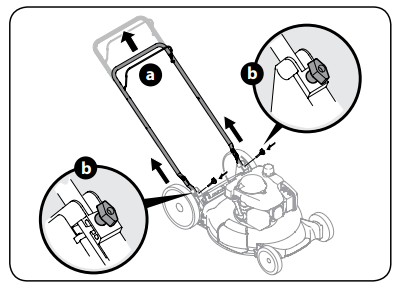
Figure 4
c. Reattach wing nuts and carriage bolts removed in Step 1 into lower holes of handle as shown in Figure 5.
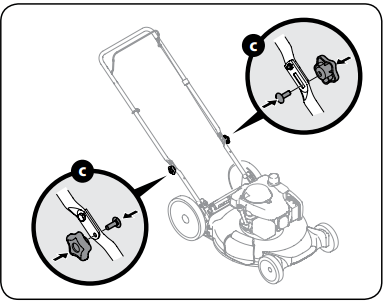
Figure 5
4. The rope guide is attached to the right side of the upper handle. Loosen the wing knob which secures the rope guide. Refer to Figure 6.
a. Hold blade control against upper handle.
b. Slowly pull starter rope handle from engine and slip starter rope into the rope guide. See Figure 6.
c. Tighten rope guide wing knob.
d. Use cable ties to secure blade control cable to lower handle.
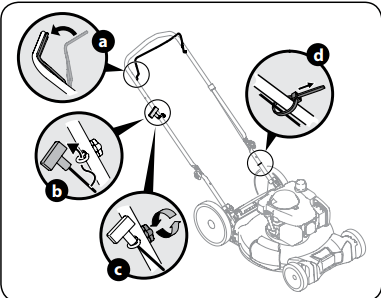
Figure 6
Attaching the Grass Catcher
1. Follow steps below to assemble the grass catcher. Make certain bag is turned right side out before assembling (warning label will be on the outside).
a. Place bag over frame so that its black plastic side is at the bottom.
b. Slip plastic channel of grass bag over hooks on the frame. See Figure 7.
2. Follow steps below to attach grass catcher:
a. Lift rear discharge door.
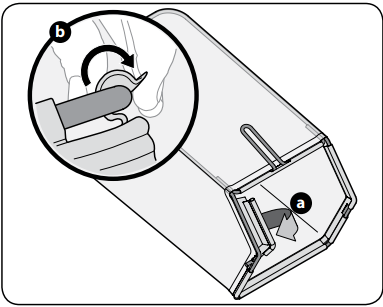
Figure 7
b. Place grass catcher into the slots in the handle brackets as shown in Figure 8. Let go of discharge door so that it rests on the grass catcher.
To remove grass catcher, lift rear discharge door on the mower. Lift grass catcher up and off the slots in the handle brackets. Release rear discharge door to allow it to close rear opening of mower.
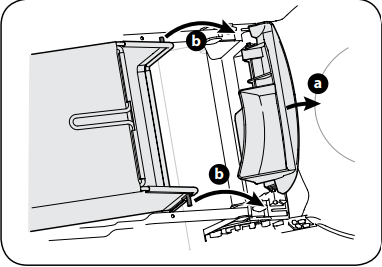
Figure 8
Attaching Side Discharge Cover
Your mower is shipped as a mulcher. To convert to side discharge, make sure grass catcher is off of the unit and rear discharge door is closed.
1. On the side of the mower, lift the mulch cover. See Figure 9.
2. Slide two hooks of side discharge cover under hinge pin on mulching cover assembly. Lower mulching cover. Do not remove side mulching cover at any time, even when you are not mulching.
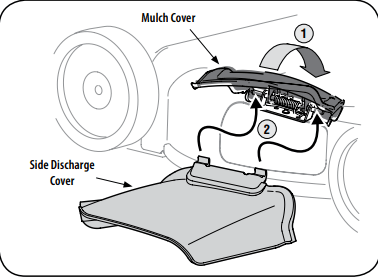
Figure 9
ADJUSTMENTS
Cutting Height
There is a cutting height adjustment lever located above the front and rear right wheel.
- Pull the height adjustment lever outward towards wheel (unit will tend to fall when lever is moved outward). See Figure 10.
- Move lever to desired position for a change in cutting height. See Figure 10.
- Release lever towards deck.
IMPORTANT: All wheels must be placed in the same position. For rough or uneven lawns, move each height adjustment lever to a higher position. This will prevent you from cutting the grass too close to the ground.
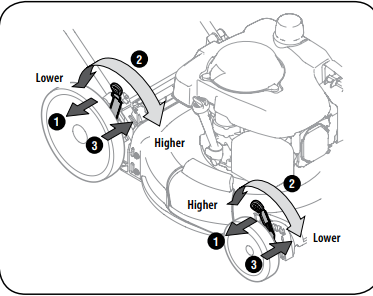
Figure 10
Handle Pitch (If Equipped)
For convenience of operation, you may adjust the pitch of the handle as follows:
Remove wing nuts and carriage bolts from handle. See Figure 11.
Position the handle in one of the three positions that is most comfortable. See Figure 11 inset.
Secure into position with wing nuts and carriage bolts removed in Step 1.
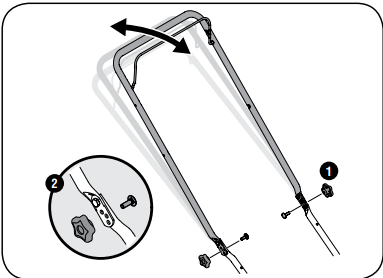
Figure 11
OPERATION
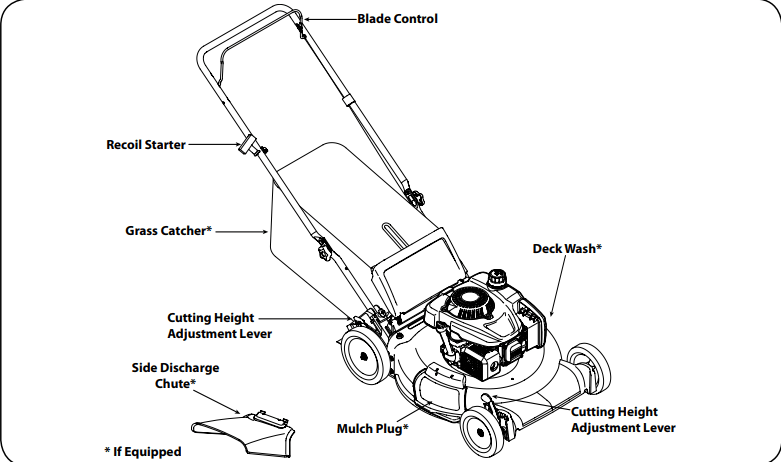
Blade Control
The blade control is attached to the upper handle of the mower. Depress and squeeze it against the upper handle to operate the unit. Release it to stop engine and blade.

Cutting Height Adjustment Lever
One adjustment lever is located on the right rear wheel and one is located on the right front wheel. Both levers have to be at the same position to ensure a uniform cut. To adjust the cutting height, refer to the Assembly Section.
Deck Wash (If Equipped)
Your mower’s deck is equipped with a water port on its surface as part of its deck wash system. Use the deck wash to rinse grass clippings from the deck’s underside.
Mulch Cover (If Equipped)
The mulch cover is used for mulching purposes. Instead of collecting the grass clippings in a grass catcher or using the side discharge chute, some mower models have the option of recirculating the clippings back to the lawn. This is called mulching.
Side Discharge Cover
Your mower is shipped as a mulcher. To discharge the grass clippings to the side instead, follow the instructions on page 9 in the Assembly section to attach the side discharge cover.

Grass Catcher (If Equipped)
The grass catcher, located at the rear of the mower, is used to bag the grass clippings for disposal at another site. Once the bag is full, remove it up through the handles and empty it before any further mowing.
Trail Shield
The trail shield is attached to the rear of the mower and is there to protect the operator from flying debris. Do not use the mower unless the shield is fully functional and in place.
Recoil Starter
The recoil starter is attached to the right upper handle. Stand behind the unit and pull the recoil starter rope to start the unit.
Meets ANSI Safety Standards
Craftsman Lawn Mowers conform to the safety standard of the American National Standards Institute (ANSI).
GAS AND OIL FILL-UP
IMPORTANT: Refer to the separate Engine Operator’s Manual for additional engine information.
This unit is shipped without gasoline or oil in the engine. Be certain to service engine with gasoline and oil as instructed in this section before starting or running your machine.
Add provided oil before starting mower for the first time.
Service the engine with gasoline as instructed in the separate Engine Operator’s Manual.

To Start Engine
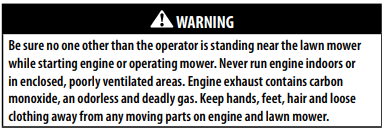
Refer to the Engine Operator’s Manual for instructions on starting and stopping the engine.

To Stop Engine
1. Release blade control to stop the engine and blade.

Using as Mulcher
For mulching grass, remove the grass catcher or side discharge chute from the mower. When you remove the grass catcher from the mower, the rear discharge door will close. When you remove the side discharge chute, the mulching cover will close. For effective mulching, do not cut wet grass. If the grass has been allowed to grow in excess of four inches, mulching is not recommended. Use the grass catcher to bag clippings instead.
Using Grass Catcher (If Equipped)
You can use the grass catcher to collect clippings while you are operating the mower.
1. Attach grass catcher following instructions on page 8 in the Assembly section. Grass clippings will automatically collect in bag as you run mower. Operate mower until grass bag is full.
2. Stop engine completely by releasing the blade control. Make sure that the unit has come to a complete stop.
3. Lift discharge door and pull grass bag up and away from the mower to remove the bag. Dispose of the grass clippings and reinstall the bag when complete.

SERVICE AND MAINTENANCE
MAINTENANCE SCHEDULE

Follow the maintenance schedule given below. This chart describes service guidelines only. Use the Service Log column to keep track of completed maintenance tasks. To locate the nearest Service Center or to schedule service, call the following toll free number:1-888-331-4569. See the Engine Operator’s manual packed with the mower for detailed instructions on how to perform many of the following maintenance items.
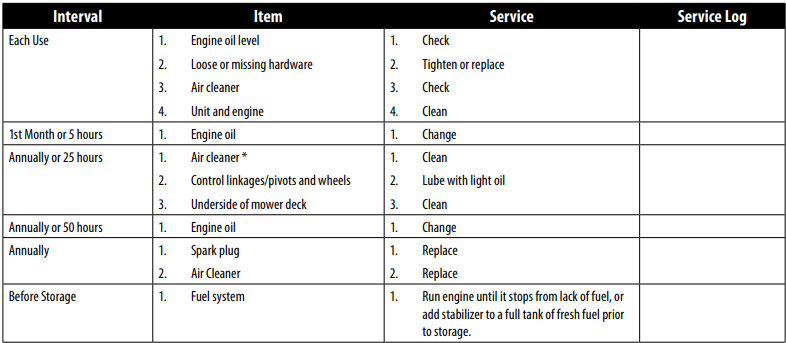
* Clean more often under dusty conditions or when airborne debris is present. Replace air cleaner if very dirty.
General Recommendations
- Always observe safety rules when performing any maintenance.
- The warranty on this lawn mower does not cover items that have been subjected to operator abuse or negligence. To receive full value from warranty, operator must maintain the equipment as instructed here.
- Changing of engine-governed speed will void engine warranty.
- All adjustments should be checked at least once each season.
- Periodically check all fasteners and make sure these are tight.
Lubrication
Blade Control
Lubricate pivot points on the blade control at least once a season with light oil. This control must operate freely in both directions. See Figure 13.

Figure 13.
Engine Maintenance
Refer to the Engine Operator’s Manual packed with your mower for a detailed description of all engine-related service specifications.
Clean Engine
- Daily or before every use, clean grass, chaff or accumulated debris from engine. Keep linkage, spring, and controls clean. Keep area around and behind muffler free of any combustible debris.
- Keeping engine clean allows air movement around engine.
- Engine parts should be kept clean to reduce the risk of overheating and ignition of accumulated debris.

Mower Maintenance
Cleaning Deck
Clean underside of the mower deck once a season to prevent build-up of grass clippings or other debris. Follow steps below for this job.
1. Allow the engine to run until it is out of fuel. Do not attempt to pour fuel from the engine. Disconnect spark plug wire. Refer to Engine Operator’s Manual.
2. Tip mower so that it rests on the housing, keeping the muffler side down. Hold mower firmly.

3. Scrape and clean the underside of the deck with a suitable tool. Do not spray with water.
IMPORTANT: Do not use a pressure washer or garden hose to clean your unit. These may cause damage to bearings, or the engine. The use of water will result in shortened life and reduce serviceability.
4. Put the mower back on its wheels on the ground.
Deck Wash (If Equipped)
Your mower’s deck is equipped with a water port on its surface as part of its deck wash system.
Use the deck wash to rinse grass clippings from the deck’s underside and prevent the buildup of corrosive chemicals. Complete the following steps AFTER EACH MOWING:
1. Push the mower to a level, clear location on your lawn, near enough for your garden hose to reach. Remove the grass bag if attached.

2. Remove the fast attach deck wash nozzle from the mower deck and thread it onto the end of your garden hose.
3. Attach garden hose with the deck wash nozzle to the water port on your deck’s surface. See Figure 14.
4. Turn the water ON.
5. Start the engine as described in the Operation section.
6. Run the engine for a minimum of two minutes, allowing the underside of the cutting deck to thoroughly rinse.
7. Release blade control to stop the engine and blade.
8. Turn the water OFF and detach the deck wash nozzle from the water port on your deck’s surface.
After cleaning your deck, restart the mower. Keep the engine and blade running for a minimum of two minutes, allowing the underside of the cutting deck to thoroughly dry
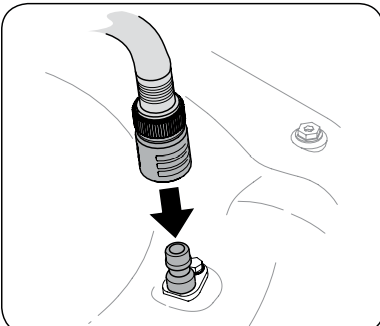
Figure 14
Blade Care

Periodically inspect the blade adapter for cracks, especially if you strike a foreign object. Replace when necessary. Follow the steps below for blade service.
1. Allow the engine to run until it is out of fuel. Do not attempt to pour fuel from the engine. Disconnect spark plug wire. Refer to Engine Operator’s Manual.
2. Turn mower on its side making sure that the air filter and the carburetor are facing up.
3. Remove the bolt and the blade bell support which hold the blade and the blade adapter to the engine crankshaft. See Figure 15.
4. Remove blade and adapter from the crankshaft.
5. Remove blade from the adapter for testing balance. Balance the blade on a round shaft screwdriver to check. Remove metal from the heavy side until it balances evenly. When sharpening the blade, follow the original angle of grind. Grind each cutting edge equally to keep the blade balanced.

6. Lubricate the engine crankshaft and the inner surface of the blade adapter with light oil. Slide the blade adapter onto the engine crankshaft. Place the blade on the adapter such that the side of the blade marked “Grass Side” (or with part number) faces the ground when the mower is in the operating position. Make sure that the blade is aligned and seated on the blade adapter flanges. See Figure 15 inset.
7. Place blade bell support on the blade. Align notches on the blade bell support with small holes in blade.
8. Replace hex bolt and tighten hex bolt to torque: 450 in-lb (min.), 600 in-lb (max.). To ensure safe operation of your mower, periodically check the blade bolt for correct torque.
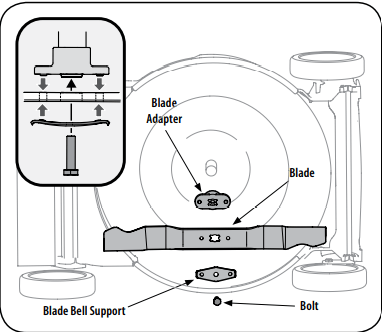
Figure 15
OFF-SEASON STORAGE
Never store lawn mower with fuelin tank indoors or in poorly ventilated areas where fuel fumes may reach an open flame, spark, o pilot light as on a furnace, water heater, clothes dryer, or gas appliance
Preparing The Engine
For engines stored over 30 days:
- To prevent gum from forming in fuel system or on carburetor parts, run engine until it stops from lack of fuel or add a gasoline additive to the gas in the tank. If you use a gas additive, run the engine for several minutes to circulate the additive through the carburetor.
- An oil change is not required but if you desire to change the oil then change while the engine is warm.
- Clean engine of surface debris.
Preparing The Lawn Mower
- Clean and lubricate mower thoroughly as described in the lubrication instructions.
- Do not use a pressure washer or garden hose to clean your unit.
- Coat mower's cutting blade with chassis grease to prevent rusting.
Warning: When handling the cutting blade, protect your hands gloves or use a heavy rag to hold the blade.
Refer to Preparing the Engine for correct engine storage instructions.
Store mower in a dry, clean area. Do not store next to corrosive materials. such as fertilizer.
When storing any type of power equipment in a poorly ventilated or metal storage shed, care should be taken to rust-proof the equipment. Using a light oil or silicone. coat the equipment, especially cables and all moving parts of your lawn mower before storage.
Battery
The battery must be stored with a full charge. Extended storage of a discharged battery will reduce life and capacity of the battery. For optimal battery life, charge the battery once per month while in storage.
Remove electric start push key and keep in a safe place out of the reach of children.
TROUBLESHOOTING
This section addresses minor service issues. To locate the nearest Service Center or to schedule service, call the following toll free number: 1-888-331-4569.
WARNING: Disconnect the spark plug wire and ground it against the engine to prevent unintended starting. Before performing any type of maintenance/service, disengage all controls and stop the engine. Wait until all moving parts have come to a complete stop. Always wear safety glasses during operation or while performing any adjustments or repairs.
| Engine fails to start |
|
|
| Engine fails to start with electric starter (Electric Start Units Only) |
|
|
| Engine runs erratic |
|
|
| Engine overheats |
|
|
| Occasional skips (hesitates) |
|
|
| Idles poorly |
|
|
| Excessive vibration |
|
|
| Mower will not mulch grass |
|
|
| Uneven cut |
|
|
SAFETY INSTRUCTIONS
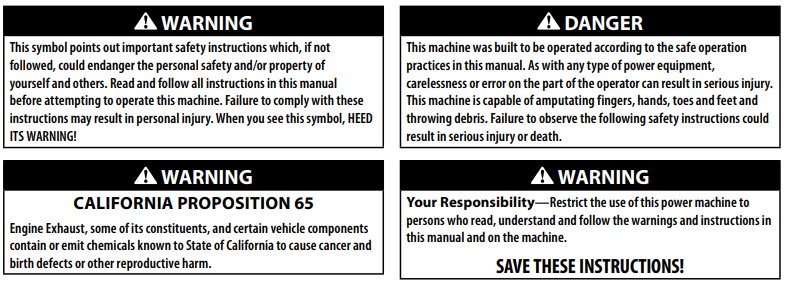
GENERAL OPERATION
- Read this operator’s manual carefully in its entirety before attempting to assemble this machine. Read, understand, and follow all instructions on the machine and in the manuals before operation. Keep this manual in a safe place for future and regular reference and for ordering replacement parts
- Be completely familiar with the controls and the proper use of this machine before operating it.
- This machine is a precision piece of power equipment, not a plaything. Therefore, exercise extreme caution at all times. This machine has been designed to perform one job: to mow grass. Do not use it for any other purpose.
- Never allow children under 14 years of age to operate this machine. Children 14 and over should read and understand the instructions and safe operation practices in this manual and on the machine and should be trained and supervised by an adult.
- Only responsible individuals who are familiar with these rules of safe operation should be allowed to use this machine.
- Thoroughly inspect the area where the equipment is to be used. Remove all stones, sticks, wire, bones, toys and other foreign objects, which could be tripped over or picked up and thrown by the blade. Thrown objects can cause serious personal injury.
- Plan your mowing pattern to avoid discharge of material toward roads, sidewalks, bystanders and the like. Also, avoid discharging material against a wall or obstruction, which may cause discharged material to ricochet back toward the operator.
- To help avoid blade contact or a thrown object injury, stay in operator zone behind handles and keep children, bystanders, helpers and pets at least 75 feet from mower while it is in operation. Stop machine if anyone enters area.
- Always wear safety glasses or safety goggles during operation and while performing an adjustment or repair to protect your eyes. Thrown objects which ricochet can cause serious injury to the eyes.
- Wear sturdy, rough-soled work shoes and close-fitting slacks and shirts. Shirts and pants that cover the arms and legs and steel-toed shoes are recommended. Never operate this machine in bare feet, sandals, slippery or light-weight (e.g. canvas) shoes.
- Do not put hands or feet near rotating parts or under the cutting deck. Contact with blade can amputate fingers, hands, toes and feet.
- A missing or damaged discharge cover can cause blade contact or thrown object injuries. •
- Many injuries occur as a result of the mower being pulled over the foot during a fall caused by slipping or tripping. Do not hold on to the mower if you are falling: release the handle immediately.
- Never pull the mower back toward you while you are walking. If you must back the mower away from a wall or obstruction first look down and behind to avoid tripping and then follow these steps:
- a. Step back from mower to fully extend your arms forward
- b. Be sure you are well balanced with sure footing.
- c. Pull the mower back slowly, no more than half way toward you
- d. Repeat these steps as needed.
- Do not operate the mower while under the influence of alcohol or drugs.
- Do not engage the self-propelled mechanism on machines so equipped while starting engine.
- The blade control handle is a safety device. Never attempt to bypass its operation. Doing so makes the safety device inoperative and may result in personal injury through contact with the rotating blade. The blade control handle must operate easily in both directions and automatically return to the disengaged position when released.
- Never operate the mower in wet grass. Always be sure of your footing. A slip and fall can cause serious personal injury. If you feel you are losing your footing, release the blade control handle immediately and the blade will stop rotating within three seconds.
- Mow only in daylight or good artificial light. Walk, never run.
- Stop the blade when crossing gravel drives, walks or roads.
- If the equipment should start to vibrate abnormally, stop the engine and check immediately for the cause. Vibration is generally a warning of trouble.
- Shut the engine off and wait until the blade comes to a complete stop before removing the grass Bagger or unclogging the chute. The cutting blade continues to rotate for a few seconds after the blade control is released. Never place any part of the body in the blade area until you are sure the blade has stopped rotating.
- Never operate mower without proper trail shield, discharge cover, grass Bagger, blade control handle or other safety protective devices in place and working. Never operate mower with damaged safety devices. Failure to do so can result in personal injury.
- Muffler and engine become hot and can cause a burn. Do not touch.
- Never attempt to make a wheel or cutting height adjustment while the engine is running.
- Only use parts and accessories made for this machine by the manufacturer. Failure to do so can result in personal injury.
- When starting engine, pull cord slowly until resistance is felt, then pull rapidly. Rapid retraction of starter cord (kickback) will pull hand and arm toward engine faster than you can let go. Broken bones, fractures, bruises or sprains could result.
- If situations occur which are not covered in this manual, use care and good judgement.
SLOPE OPERATION
Slopes are a major factor related to slip and fall accidents, which can result in severe injury. Operation on slopes requires extra caution. The machine is heavy and can speed up when going downhill. Be prepared to maintain control of the machine. If you feel uneasy on a slope, do not mow it. For your safety, use the slope gauge included as part of this manual to measure slopes before operating this machine on a sloped or hilly area. If the slope is greater than 15 degrees, do not mow it.
Do:
- Mow across the face of slopes; never up and down to avoid loss of control.
- Exercise extreme caution when changing direction on slopes; turn uphill not down.
- Watch for holes, ruts, rocks, hidden objects, or bumps which can cause you to slip or trip. Tall grass can hide obstacles.
- Always be sure of your footing. A slip and fall can cause serious personal injury. If you feel you are losing your balance, release the blade control handle immediately and the blade will stop rotating within three (3) seconds.
Do Not:
- Do not mow near drop-offs, ditches or embankments, because you could lose your footing or balance.
- Do not mow slopes greater than 15 degrees as shown on the slope guide.
- Do not mow on wet grass. Unstable footing could cause slipping.
CHILDREN
Tragic accidents can occur if the operator is not alert to the presence of children. Children are often attracted to the mower and the mowing activity. They do not understand the dangers. Never assume that children will remain where you last saw them.
- Keep children out of the mowing area and under watchful care of a responsible adult other than the operator.
- Be alert and turn mower off if a child enters the area.
- Before and while moving backwards, look behind and down for small children.
- Use extreme care when approaching blind corners, doorways, shrubs, trees, or other objects that may obscure your vision of a child who may run into the mower.
- Keep children away from hot or running engines. They can suffer burns from a hot muffler.
- Never allow children under 14 years of age to operate this machine. Children 14 and over should read and understand the instructions and safe operation practices in this manual and on the machine and be trained and supervised by an adult.
SERVICE
Safe Handling of Gasoline:
To avoid personal injury or property damage use extreme care in handling gasoline. Gasoline is extremely flammable and the vapors are explosive. Serious personal injury can occur when gasoline is spilled on yourself or your clothes which can ignite. Wash your skin and change clothes immediately.
- Use only an approved gasoline container.
- Never fill containers inside a vehicle or on a truck or trailer bed with a plastic liner. Always place containers on the ground away from your vehicle before filling.
- Remove gas-powered equipment from the truck or trailer and refuel it on the ground. If this is not possible, then refuel such equipment on a trailer with a portable container, rather than from a gasoline dispenser nozzle.
- Keep the nozzle in contact with the rim of the fuel tank or container opening at all times until fueling is complete. Do not use a nozzle lock-open device.
- Extinguish all cigarettes, cigars, pipes and other sources of ignition.
- Never fuel machine indoors because flammable vapors will accumulate in the area.
- Never remove gas cap or add fuel while engine is hot or running. Allow engine to cool at least two minutes before refueling.
- Never over-fill fuel tank. To allow for expansion of the fuel, do not fill above the bottom of the fuel tank neck.
- Replace gasoline cap and tighten securely.
- If gasoline is spilled, wipe it off the engine and equipment. Move machine to another area. Wait 5 minutes before starting engine.
- Never store the machine or fuel container near an open flame, spark or pilot light as on a water heater, space heater, furnace, clothes dryer or other gas appliances.
- To reduce fire hazard, keep machine free of grass, leaves, or other debris build-up. Clean up oil or fuel spillage and remove any fuel-soaked debris.
- Allow machine to cool at least 5 minutes before storing.
General Service:
- Never run an engine indoors or in a poorly ventilated area. Engine exhaust contains carbon monoxide, an odorless and deadly gas.
- Before cleaning, repairing, or inspecting, make certain the blade and all moving parts have stopped. Disconnect the spark plug wire and ground against the engine to prevent unintended starting.
- Check the blade and engine mounting bolts at frequent intervals for proper tightness. Also, visually inspect blade for damage (e.g., bent, cracked, worn). Replace blade with the original equipment manufacture’s (O.E.M.) blade only. Use of parts which do not meet the original equipment specifications may lead to improper performance and compromise safety!
- Mower blades are sharp and can cut. Wrap the blade or wear gloves, and use extra caution when servicing them.
- Keep all nuts, bolts, and screws tight to be sure the equipment is in safe working condition.
- Never tamper with safety devices. Check their proper operation regularly.
- After striking a foreign object, stop the engine, disconnect the spark plug wire and ground against the engine. Thoroughly inspect the mower for any damage. Repair the damage before starting and operating the mower.
- Never attempt to make a wheel or cutting height adjustment while the engine is running.
- Grass Bagger components, discharge cover, and trail shield are subject to wear and damage which could expose moving parts or allow objects to be thrown. For safety protection, frequently check components and replace immediately with original equipment manufacturer’s (O.E.M.) parts only. Use of parts which do not meet the original equipment specifications may lead to improper performance and compromise safety!
- Do not change the engine’s governor setting or over-speed the engine. The governor controls the maximum safe operating speed of the engine.
- Check fuel line, tank, cap, and fittings frequently for cracks or leaks. Replace if necessary.
- Do not crank engine with spark plug removed.
- Maintain or replace safety and instruction labels, as necessary.
- Observe proper disposal laws and regulations. Improper disposal of fluids and materials can harm the environment.
- According to the Consumer Products Safety Commission (CPSC) and the U.S. Environmental Protection Agency (EPA), this product has an Average Useful Life of seven (7) years, or 140 hours of operation. At the end of the Average Useful Life have the machine inspected annually by a qualified service dealer to ensure that all mechanical and safety systems are working properly and not worn excessively. Failure to do so can result in accidents, injuries or death.
DO NOT MODIFY ENGINE
To avoid serious injury or death, do not modify engine in any way. Tampering with the governor setting can lead to a runaway engine and cause it to operate at unsafe speeds. Never tamper with factory setting of engine governor.
NOTICE REGARDING EMISSIONS
Engines which are certified to comply with California and federal EPA emission regulations for SORE (Small Off Road Equipment) are certified to operate on regular unleaded gasoline, and may include the following emission control systems: Engine Modification (EM), Oxidizing Catalyst (OC), Secondary Air Injection (SAI) and Three Way Catalyst (TWC) if so equipped.
SPARK ARRESTOR

If a spark arrestor is used, it should be maintained in effective working order by the operator. In the State of California the above is required by law (Section 4442 of the California Public Resources Code). Other states may have similar laws. Federal laws apply on federal lands. A spark arrestor for the muffler is available through your nearest Parts and Repair Service Center. For location and purchase information call 1-888-331-4569.
SAFETY SYMBOLS
This page depicts and describes safety symbols that may appear on this product. Read, understand, and follow all instructions on the machine before attempting to assemble and operate.
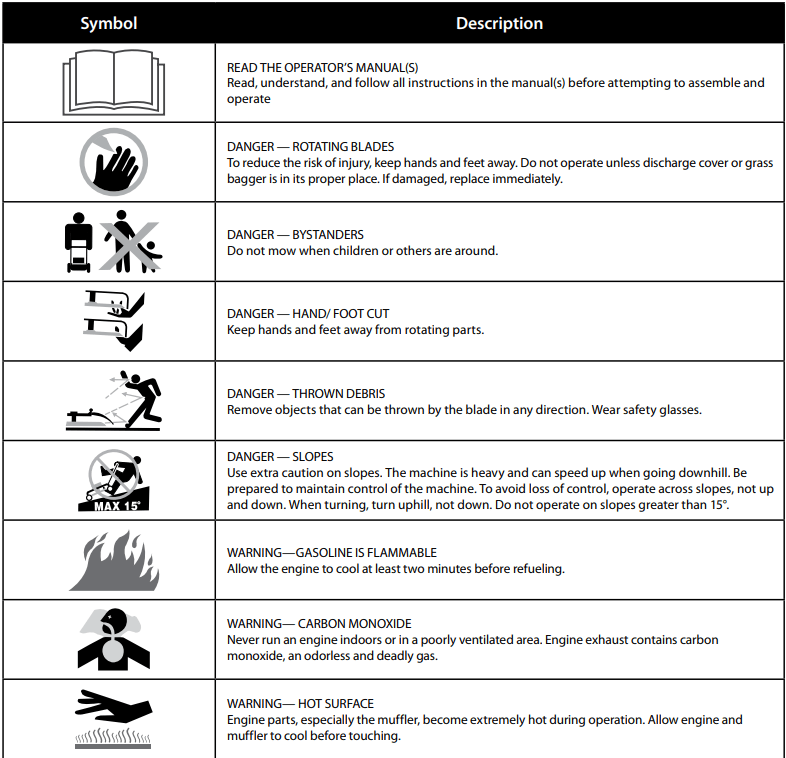

See other models: CMEMW213 30790 139.53985DM CMXEMAR120 CMXEMAX69434501

